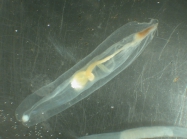
| About | | Search taxa | | Taxon tree | | Search literature | | Specimens | | Distribution | | Checklist | | Stats | | Log in |
Polychaeta taxon detailsPoeobius Heath, 1930
324619 (urn:lsid:marinespecies.org:taxname:324619)
accepted
Genus
Poeobius meseres Heath, 1930 (type by monotypy)
marine,
recent only
Heath, Harold. (1930). A connecting link between the Annelida and the Echiuroidea (Gephyrea armata). <em>Journal of Morphology.</em> 49(1): 223-249., available online at https://onlinelibrary.wiley.com/doi/10.1002/jmor.1050490106 [details]
Etymology Heath gives an etymology from Greek, with 'Poeus' he says meaning 'of what nature' and 'Bios' meaning 'life', so presumably...
Etymology Heath gives an etymology from Greek, with 'Poeus' he says meaning 'of what nature' and 'Bios' meaning 'life', so presumably he was indicating the uncertain affinities of the worm, and 'meseres' he says means intermediate. So he apparently was using the epithet to answer the question he posed with the genus name - of what nature of life [was this], and the answer was an intermediate [form of life]. [details]
Read, G.; Fauchald, K. (Ed.) (2024). World Polychaeta Database. Poeobius Heath, 1930. Accessed at: https://marinespecies.org/polychaeta/aphia.php?p=taxdetails&id=324619 on 2024-04-26
Date action by
original description
Heath, Harold. (1930). A connecting link between the Annelida and the Echiuroidea (Gephyrea armata). <em>Journal of Morphology.</em> 49(1): 223-249., available online at https://onlinelibrary.wiley.com/doi/10.1002/jmor.1050490106 [details]
additional source Fisher, W. K. (1946). Echiuroid worms of the North Pacific Ocean. <em>Proceedings of the United States National Museum.</em> 96: 215–292, plates 20–37., available online at https://www.biodiversitylibrary.org/page/7311441 page(s): 218; note: proposed phylum Poeobioidea for Poeobius [details] status source Burnette, Adriene B.; Struck, Torsten H.; Halanych, Kenneth M. (2005). Holopelagic <i>Poeobius meseres</i> (Poeobiidae, Annelida) is derived from benthic flabelligerid worms. <em>The Biological Bulletin (Woods Hole).</em> 208(3): 213-220., available online at https://doi.org/10.2307/3593153 note: To Flabelligeridae [details] Available for editors status source Pickford, G. E. (1947). Histological and histochemical observations upon an aberrant annelid, Poeobius meseres Heath. <em>Journal of Morphology.</em> 80(3): 287-319. note: placed as an annelid [details] From editor or global species database
Classification On Poeobius Heath, 1930 Fisher wrote (1946, p.218) "A tenable hypothesis is that the echiuroids and Poeobius stemmed from a common group that was as fundamentally unsegmented as the Amphineura among mollusks. According to this view Poeobius is the survivor of a lesser phylum, comparable to the Phoronidea and Priapuloidea. As the genus now floats in a sort of taxonomic limbo, it may be provisionally assigned to a new phylum, POEOBIOIDEA." However, the annelid nature of Poeobius was discovered soon after (Pickford, 1947). Hyman (1959: 697, 'Smaller Coelomate groups') dismissed the idea of a new phylum with the words "Poeobioidea is therefore to be obliterated." [details]Etymology Heath gives an etymology from Greek, with 'Poeus' he says meaning 'of what nature' and 'Bios' meaning 'life', so presumably he was indicating the uncertain affinities of the worm, and 'meseres' he says means intermediate. So he apparently was using the epithet to answer the question he posed with the genus name - of what nature of life [was this], and the answer was an intermediate [form of life]. [details] |
